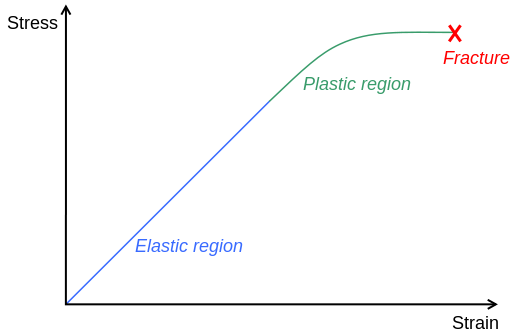Hardness
Hardness is the measure of how well a solid object can resist shape change when being exposed to compressive forces.
The Main Idea
Properties of Matter
Properties of matter are divided into two categories, chemical and physical. Hardness falls in the physical category; it can be determined without altering the matter. It is an unusual property because it is not an intrinsic property which can be defined in terms of fundamental SI units. Hardness can be difficult to calculate.
Hardness
Hardness is the measure of how well a solid object can resist shape change when being exposed to compressive forces. There is a link between hardness and chemical composition. This is due to the solid matter's crystal structure.
Why it matters
Solid matter generally has 3 responses to forces, depending on the force type and amount. Elasticity, plasticity, and fracture. Elasticity is the ability to return to original shape after force has been applied. Plasticity is the solid matter's ability to remain one piece. Fracture is when the solid matter splits into two or more pieces. Stress versus strain graphs show how these responses are related. Hardness matters because it is important to know what matters will be able to withstand certain forces and be resistant to deformation, indentation, or penetration.
Calculating Hardness
Contrary to many physical properties, there is no one way of calculating hardness. In fact, there are many hardness tests, such as the Brinell, Knoop, Rockwell, and Vickers tests, that aim to obtain approximations of hardness of one material relative to other materials.
Brinell Scale
The Brinell Scale was the first widely-used and standardized scale to determine the hardness of a material. It used an indentation method to measure hardness, ultimately limiting its usefulness due to possible damage to the test-pieces. The test typically involves a steel rod ( of a 10mm diameter) used as an indenter with a constant force of 3,000 kgf. With particularly soft/hard substances, changes are made to the force and material of the rod. The BHN (Brinell Hardness Number) is calculating in the following way: BHN = 2P/pi*D*(D-sqrt(D^2-d^2)) where: BHN = Brinell Hardness Number (kgf/mm2) d = diameter of indentation (mm) P = applied load in kilogram-force (kgf) D = diameter of indenter (mm)
Knoop Scale
The Knoop hardness test is typically used for thin sheets or particularly brittle materials, where a large indentation would damage the testing material too much. In this test, a small pyramidal diamond point is pressed into a generally fixed amount of material. Because the pointed tip of the indenter is standard, the depth does not have to be measured; rather, the length of the indentation is measured (it is approximately 30 times the size of the depth). The Knoop Hardness (HK) is calculated in the following way: HK = P/Cp*L^2 where: L = length of indentation along its long axis Cp = correction factor related to the shape of the indenter, ideally 0.070279 P = load (HK values are typically in the range from 100 to 1000.)
Rockwell Scale
The Rockwell scale is another indentation method to measure the hardness of a material. This test compares an indent made by a light load to one that is made by a larger load. Measuring the differences in depth of penetration yields the hardness factor. The Rockwell Hardness (HR) is calculated in the following way: HR = N - d/s where: d = depth from zero load point and N/s are both scale factors dependent on which variation is being used
Sensitivity Coefficient
These tests can be improved by the introduction of a sensitivity coefficient. Sensitivity coefficients are used to determine the factor that different parameters, such as force, diameter, and depth have on hardness.
The Sensitivity coefficient [math]\displaystyle{ c_{i} }[/math], is defined as the change in hardness H, over the input parameter [math]\displaystyle{ x_{i} }[/math]:
[math]\displaystyle{ c_{i} = \frac{\Delta H}{\Delta x_{i}} }[/math]
Examples and History
Mohs hardness scale
There is no standard hardness scale, but of the Mohs scale is the most commonly used. The Mohs scale of mineral hardness organizes the scratch resistance of various minerals. It does this by determining and ranking the ability of a harder material to scratch a softer material. It is named after its creator, Friedrich Mohs, a German mineralogist.
See also
https://en.wikipedia.org/wiki/Mohs_scale_of_mineral_hardness
http://www.npl.co.uk/upload/pdf/brinell_hardness_co.pdf
http://www.npl.co.uk/upload/pdf/vickers_hardness_co.pdf
External links
http://physicsworld.com/cws/article/news/2006/mar/09/how-to-calculate-hardness
References
http://physicsworld.com/cws/article/news/2006/mar/09/how-to-calculate-hardness
http://chemwiki.ucdavis.edu/Analytical_Chemistry/Chemical_Reactions/Properties_of_Matter
https://en.wikipedia.org/wiki/Mohs_scale_of_mineral_hardness
https://en.wikipedia.org/wiki/File:Stress-strain1.svg
http://www.npl.co.uk/science-technology/mass-and-force/hardness/
Sarah Gould
